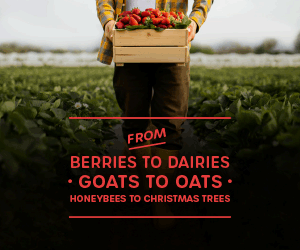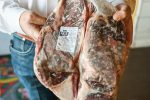Award-Winning Hoosier Farmers Cultivate Climate-Conscious Farming in Indiana

Kelli and Ryan Chalfant stand by the solar panels that power their grain bins at Chalfant Family Farms in Farmland. Photo credit: Nathan Lambrecht
Conservation is a major priority on many Hoosier farms. Indiana farmers ensure a future for the land and farming while working to feed, clothe and support consumers throughout the nation.
No Till, No Problem
Take a drive around Randolph County in east-central Indiana once harvest time is over and there will still be something to see in many of the fields. Farmers leave the stubble of the season standing in about 62% of the county’s soybean acreage and 79% of its corn, according to the latest figures from the Indiana State Department of Agriculture.
Things would have looked a lot plainer on many farms back in 1988, but not at Chalfant Family Farms outside of Farmland, Indiana. After a successful experiment using no-till agriculture on one soybean field in 1987, farmer Bob Chalfant sold every bit of his tillage equipment and went all-in on the practice.
See more: Ozark Fisheries Molds Martinsville the “Goldfish Capital of the World”

Photo credit: Nathan Lambrecht
That experiment has expanded and continued through the present day, says Bob’s son, Ryan Chalfant, who now helps manage the operation with his wife, Kelli. The Chalfants practice no-till exclusively across more than 2,500 acres, primarily in corn-soy rotation with a small amount of wheat.
They also plant cover crops such as oats, barley and turnips on much of their land through the winter.
In recognition of these long-running efforts, Chalfant Family Farms received the 2020 Conservation Farmer of the Year award from the Indiana Association of Soil and Water Conservation Districts. According to the Indiana Conservation Partnership, practices such as no-till and cover cropping help prevent erosion while building healthier agricultural soils.

Chalfant Family Farms near Farmland has always prioritized conservation efforts, including no-till practices and cover crops. Photo credit: Nathan Lambrecht
For Chalfant, the work has made economic sense, too. In addition to preserving soils, no-till agriculture can provide a better return on farming investment because there’s less need to make passes over the fields in a tractor.
He says he’s gradually seen Randolph County convert to no-till over the decades as farmers realize the extra tillage work doesn’t necessarily create more profit. He’s even proved the point to himself when testing out strip-tilling efforts, where a narrow strip is tilled in the rows in which the crop will be planted.

Photo credit: Nathan Lambrecht
“I tried strip tilling for two years, thinking I could get a pretty good increase in yield on it,” Chalfant says. “My no-till ground was yielding the same as my strip-till ground when weighing side by side, and I didn’t have any of the extra time, labor and equipment cost in it.”
The Chalfants continue to refine their no-till approach through soil testing, different fertilizer routines and the use of root-dwelling bacteria that help their plants take up nutrients.
They’re taking conservation measures outside the fields as well. The farm boasts solar panels on its grain bins, generating about 90% of the electricity needs.
See more: Mother and Daughter Duo Keep the Losure Farms Legacy Alive

Photo credit: Mike Brocksmith
Pioneer Spirits
Over in Vincennes on the western side of the state, Mike and Susan Brocksmith were also early adopters of no-till and cover cropping. In the early 1990s, having previously tried out the practices, they fully committed to transitioning thousands of acres of corn and soybeans to more conservation-minded farming.
“We were definitely alone in doing that,” Mike Brocksmith says. “People are slow to change, and I know there were a few snickers.”

The Brocksmiths in Vincennes host several farm visits to showcase their climate-smart efforts, such
as cover crop root analysis. Photo credit: Mike Brocksmith
But people have changed. As of 2022, about 39% of Knox County farmland was planted with cover crops, the fourth-highest percentage among Indiana’s 92 counties.
The Brocksmiths received the 2020 Northeast Region Conservation Legacy Award from the American Soybean Association.
Beyond the land they manage, the Brocksmiths actively promote conservation approaches to other farmers. They regularly host small-group roundtables to discuss their practices, including an extensive network of water management features such as gradient terraces and sediment basins, as well as mentoring high school and college students.
“We want to keep other farmers from making the mistakes that we’ve made over here,” Brocksmith says. “The main thing is that people just need to start on a small scale, kind of work into it and go at their own rate.”
Due to their potential for capturing carbon dioxide, techniques such as no-till and cover cropping are having a moment. They’re considered climate-smart practices by the U.S. Department of Agriculture, which has allocated more than $3.1 billion to help farmers expand their use in the coming years. Brocksmith finds that fuss a bit amusing.
“To me, ‘climate-smart’ is kind of the current toolbox buzzword,” Brocksmith says. “We’ve been farming climate-smart for a long time, in my opinion. We just truly believe that we’re going to take care of the ground, and it will take care of us.”
See more: McGaughey Farms Celebrates a Century of Conservation










 My Indiana Home is produced for Indiana Farm Bureau members. Our mission is to connect you with the food you eat, the Indiana farmers who grow it and a rural lifestyle that is uniquely Hoosier.
My Indiana Home is produced for Indiana Farm Bureau members. Our mission is to connect you with the food you eat, the Indiana farmers who grow it and a rural lifestyle that is uniquely Hoosier.
Leave a Comment